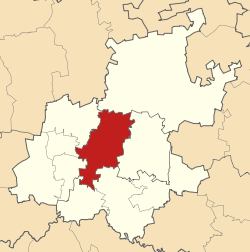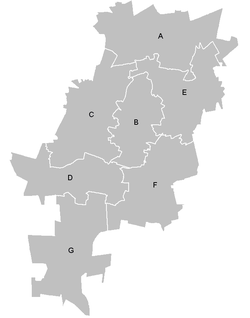- City of Johannesburg Metropolitan Municipality
-
Johannesburg Metropolitan Municipality — Metropolitan municipality — The Johannesburg Metropolitan Municipal Offices in Braamfontein Location in Gauteng Coordinates: 26°10′S 28°0′E / 26.167°S 28°ECoordinates: 26°10′S 28°0′E / 26.167°S 28°E Country South Africa Province Gauteng Area - Total 1,645 km2 (635.1 sq mi) Population (2007)[1] - Total 3,888,180 - Density 2,363.6/km2 (6,121.8/sq mi) - Households 1,165,014 Racial makeup[2] (2007) - Black African 74.79% - White 15.02% - Coloured 5.90% - Indian or Asian 4.30% Time zone SAST (UTC+2) Municipal code JHB Website http://www.joburg.org.za The City of Johannesburg Metropolitan Municipality is a metropolitan municipality that manages the local governance of Johannesburg, South Africa. It is divided into several branches and departments in order to expedite services for the city.
Johannesburg is a divided city: the poor mostly live in the southern suburbs or on the peripheries of the far north, and the middle class live largely in the suburbs of the central and north. Around 20% of the city lives in abject poverty in informal settlements that lack proper roads, electricity, or any other kind of direct municipal service. Another 40% live in inadequate housing with insufficient municipal housing.
Contents
History
During the apartheid era, Johannesburg was divided into 11 local authorities, seven of which were white and four black or coloured. The white authorities were 90% self-sufficient from property tax and other local taxes, and spent Rand 600 (USD $93) per person, while the black authorities were only ten percent self-sufficient, spending Rand 100 (USD $15) per person.
The first post-apartheid City Council was created in 1995. The council adopted the slogan "One City, One Taxpayer" in order to highlight its primary goal of addressing inequal tax revenue distribution. To this end, revenue from wealthy, traditionally white areas would help pay for services needed in poorer, black areas. The City Council was divided into four regions, each with a substantially autonomous local regional authority that was to be overseen by a central metropolitan council. Furthermore, the municipal boundaries were expanded to include wealthy satellite towns like Sandton and Randburg, poorer neighbouring townships such as Soweto and Alexandra, and informal settlements like Orange Farm. The four councils or Metropolitan Local Councils (MLCs) were the Northern MLCl, Southern MLC, Eastern MLC and Western MLC (sometimes referred to as Metropolitan Substructures), under a central metropolitan council.[3] This arrangement ended in 2000.[4]
In 1999, Johannesburg appointed a city manager in order to reshape the city's ailing financial situation. The manager, together with the Municipal Council, drew up a blueprint called "Igoli 2002". This was a three-year plan that called upon the government to sell non-core assets, restructure certain utilities, and required that all others become self-sufficient. The plan took the city from near insolvency to an operating surplus of Rand 153 million (USD 23.6 million).
The plan was fiercely contested by trade unions, who argued that it would result in job losses and tariff increases. The core of Igoli 2002 was to restructure Metro Gas, Rand Airport, and some sports stadiums as stand-alone corporate entitites. The city bus service, the Johannesburg Zoo, the Civic Theatre, the Fresh Produce Market, and the city's property holdings were turned into corporations with the city as the single shareholder. Each was run as a business, with management hired on performance contracts.
2010/11 billing and contact centre crises
The municipality faced a qualified audit from the Auditor-General following a large number of billing issues, as the result of the flawed implementation of a SAP system.[5]
The city's call centre also experienced a crisis at the same time, with staff refusing to work.[6][7]
City structure
Each province determines the structure of local government in its region. Gauteng province, run by the African National Congress, has opted for an executive mayor system. The new Johannesburg system is more efficient than before, with clearer lines of responsibility and less duplication of functions.[citation needed]
The newly unified city is ruled by Johannesburg's first executive mayor, as previously the mayor was a largely ceremonial position. Amos Mosondo, the current mayor, was chosen to be the mayor by the ANC's national executive office. The mayor takes ultimate responsibility for the city and leads a 10-person City Council.
The city management team implements decisions taken by the City Council and monitors the performance of the various branches of the city government. The group's head office is the Metro Centre Complex in Braamfontein, which is responsible for overall administration, financial control, supply of services, and collection of revenues. The fire department and ambulances, the metropolitan police and traffic control, museums, art galleries, and heritage sites are all controlled by separate departments within the central administration.
Some of the key city service functions are supplied by separate, self-contained entities, each run on business lines with its own CEO, each entering into service contracts with the administrative core. They are:
There are 10 utilities, including electricity which is run by City Power Johannesburg , water and sanitation which is run by Johannesburg Water, and solid waste management, also known as Pikitup. Utilities are registered companies, run on business lines. They must be self-funding, receiving no annual grants from the city. They provide billable services direct to individual households.
Agencies include Johannesburg Roads, City Parks and Johannesburg Development Agency. Each of these performs a service to the public at large – there are no direct charges to individual consumers. These are also structured as separate companies, but they are reliant on the council for funding.
The zoo, Civic Theatre, bus service, fresh produce market and property company each compete in the open market to "sell" their wares to individual consumers who choose to pay for their services. These departments have been "corporatised" into separate businesses, run by new managements on performance contracts, and tasked to cut their subsidy levels by R100-million in the next five years.
Regions
Main article: Regions of JohannesburgNew Administrative Regions
(2006-)Region A Diepsloot, Kya Sand Region B Randburg, Rosebank, Emmarentia, Greenside, Melville, Northcliff, Rosebank, Parktown, Parktown North Region C Roodepoort, Constantia Kloof, Northgate Region D Doornkop, Soweto, Dobsonville, Protea Glen Region E Alexandra, Wynberg, Sandton Region F Inner City Region G Orange Farm, Ennerdale, Lenasia The administration of the City of Johannesburg Metropolitan Municipality was decentralised initially into 11 regions (that were not related to the 11 former apartheid administrations). These new regions were subsequently reduced in number to 7 regions in 2006.[8] Each region is operationally responsible for the delivery of health care, housing, sports and recreation, libraries, social development, and other local community-based services.
City councillors
There are two kinds of city councillors: those who have won office in one of Johannesburg's 109 electoral wards, and those who are elected by proportional representation on the basis of party lists. The directly appointed councillors have more responsibilities, including setting up committees in their wards to raise local issues and liaising with local ratepayers' and residents' associations. The ward councillors liaise with city management through the regional directors in their areas.
See also
References
- ^ "Community Survey, 2007: Basic Results Municipalities" (PDF). Statistics South Africa. http://www.statssa.gov.za/Publications/P03011/P030112007.pdf. Retrieved 20 October 2009.
- ^ "Community Survey 2007 interactive data". Statistics South Africa. http://www.statssa.gov.za/community_new/content.asp?link=interactivedata.asp. Retrieved 19 October 2009.
- ^ http://www.capsa-events.co.za/capsa04/Documents/064.pdf
- ^ [1][dead link]
- ^ Chantelle Benjamin And Sarah Hudleston. "Billing crisis could result in qualified audit for Joburg". BusinessDay. http://www.businessday.co.za/articles/Content.aspx?id=132719. Retrieved 15 May 2011.
- ^ Mawson, Nicola (1 February 2011). "Joburg call centre collapses". ITWeb. http://www.itweb.co.za/index.php?option=com_content&view=article&id=40660:joburg-call-centre-collapses&catid=105. Retrieved 15 May 2011.
- ^ Gia Nicolaides (24 June 2009). "Joburg connect staff admit they are on a go-slow". Eyewitness News. http://www.eyewitnessnews.co.za/articleprog.aspx?id=58409. Retrieved 15 May 2011.
- ^ [2][dead link]
External links
- Official website of the City of Johannesburg
- Johannesburg Water
- Johannesburg City Parks
- Pikitup
- Johannesburg Metro Bus
- City Power Johannesburg
The City of Johannesburg Municipalities in the Province of Gauteng, South Africa Provincial Capital: Johannesburg Metropolitan District
and LocalCategories:- Government of Johannesburg
- Metropolitan Municipalities of South Africa
- Municipalities of Gauteng
Wikimedia Foundation. 2010.



